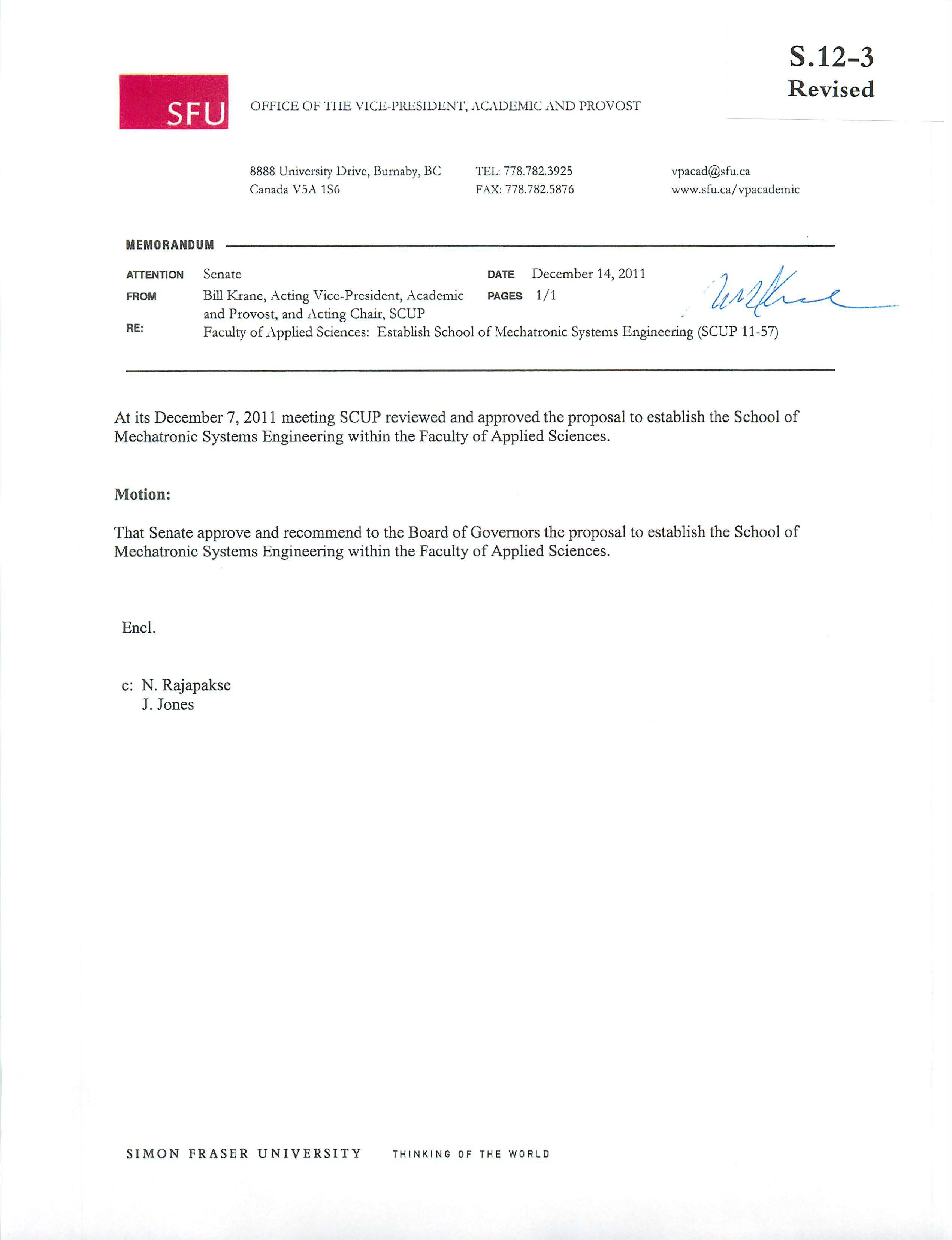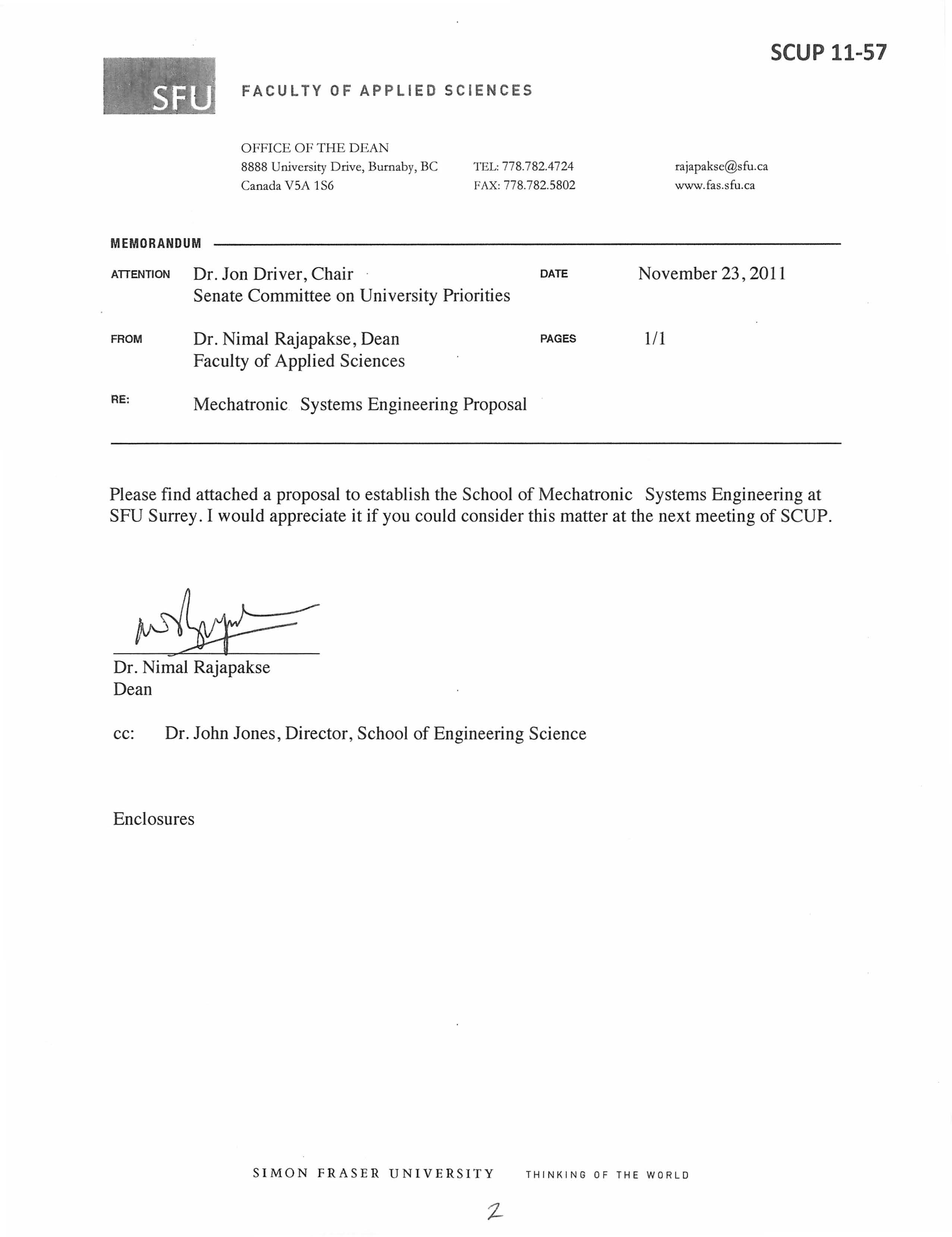OFF
I
C
E
OF
Til
E
V
I
C
E
-
l'
l
lliS
ID
ENT, ,
\
C
\
D
E
M
I
C
,
\
N
D PR
O
V
O
S
T
8888
Un
iv
cr~
i
ty
Dr
ive
, B
urna
b
y, BC
Ca
n
ada V
S
A
1
SG
T
EL: 778
.
78
2
.
3925
F
A
X
:
778.7
8
2.
5
876
M
E
M
O
R
A
N
D
UM
ATIENTlON
FRO
M
S
en
a
te
DATE
Decembe
r
14, 20
1
1
Bill Krane
,
;
\cting
V
ic
e
-
P
r
e
s
id
e
n
t,
A
ca
demic
PAGES
1
/
1
a
nd
P
rovo
s
t,
a
nd
1
\ctin
g C
hair,
SCU
P
S.12-3
Revised
v
p
a
c
a
d
@s
fu
www.s
fu
.
ca
/ vpacademi
c
RE
:
Faculty of
,
-\pplied
S
c
i
ences
: E
stablish School of
M
echatronic
Sy
stems
E
ngineering (
S
C
U
P 11
-
5
7)
At its December 7, 20 11 meeting SCUP reviewed and approved the proposal to establish the School of
Mechatronic Systems Engineering within the Facult
y
of Applied Sciences.
M
o
ti
o
n
:
T
hat
Senate approve and recommend to the Board of Governors the proposal to establish the School of
Mechatronic Systems Engineering within the
F
aculty of Applied Sciences.
E
ncl.
c
:
N. Rajapakse
J. Jones
S
IM
ON
F
RAS
E
R UNI
VE
RSIT
Y
THINKING OF THE W
O
RLD
FACULTY OF APPLIED SCIENCES
OFFICE
OF
THE DEAN
8888
Univers
i
ty
Drive, Burnaby, BC
Ca
n
ada
VSA
1
S6
TEL: 778.782.4724
FAX:
778.782.5802
MEMORANDUM
ATTENTION
Dr. Jon Driver, Chair
Senate Committee on University
Priorities
FROM
Dr. Nimal Rajapakse
,
Dean
Faculty
of Applied Sciences
RE
:
Mechatronic
Systems Engineering Proposal
DATE
PAGES
ra
japak
www.fas.s
fu.
ca
SCUP 11-57
November 23, 2011
111
Please find attached a proposal to establish the School of
Mechatronic
Systems Engineering at
SFU Surrey. I would appreciate it if you could consider this matter at the next meeting of SCUP.
~
Dr.
Nimal
Rajapakse
Dean
cc:
Dr. John Jones, Director, School
of Engineering Science
Enclosures
SIMON FRASER
UNIVERSITY
THINKING
OF THE WORLD
A Proposal to Establish the School of Mechatronic Systems Engineering
at SFU Surrey
Preamble
Submitted by Dr. Nimal Rajapakse, Dean, Faculty of Applied Sciences
November 23,2011
Planning for engineering education at SFU started in 1980. A proposal submitted in
1981 (Senate paper 81-2) envisaged the creation of a Faculty of Engineering with four academic
departments to offer programs in Civil Engineering, Chemical Engineering, Mechanical
Engineering, Electrical Engineering and Engineering Science. A subsequent proposal approved
by the Province in 1982 established the School of Engineering Science (SES) under the Faculty
of Applied Sciences. Since 1984 SES has been offering an undergraduate degree program in
Engineering Science with five concentrations.
SFU engineering was a relatively small but
honours-only program that attracted top-notch students. The Double-the-Opportunity (DTO)
initiative allowed SFU to expand its programs in computing and engineering. As a result
enrollment in Engineering Science in Burnaby has more than doubled since 2002 and a majority
of its students are now enrolled in a non-honours stream. A new program in Mechatronic
Systems Engineering (MSE) was introduced in
2006 at SFU Surrey Campus. The MSE program
is currently administered by the Director
of the School of Engineering Science, based in
Burnaby.
SES has nearly
1200 undergraduates, over 200 graduate students and 46 faculty members
between Burnaby and Surrey Campuses. The MSE share includes nearly
400 undergraduate and
over
80 graduate students (headcount) with 13 tenured/tenure-track faculty members, 4 office
staff and 3 technicians. The MSE program is completely offered at Surrey. It was recently
accredited by the Canadian Engineering Accreditation Board and the first degrees were awarded
in
October 2011.
The Director of the School of Engineering Science stepped down in July 2011 and as part
of the search for a new Director an extensive consultation of faculty, staff and student leadership
was conducted
by the Dean. Five meetings for faculty and staff were held in Surrey and Burnaby
in July. An important issue raised during these meetings was the administration of MSE. The
Faculty strategic plan developed in 2010 proposes an expansion of engineering programs at SFU
Surrey with the development of a new program in Energy Systems Engineering.
Process:
The Dean had two school meetings to discuss the issue of administration of MSE. The
meetings were very well attended. The faculty and staff members ofMSE strongly recommended
creation of a separate academic unit to administer MSE. The opinion of Burnaby faculty was
divided, their main concerns being the division of resources, competition for students and
potential duplication of certain research areas. The SES faculty members from Burnaby met
separately several times to review the current status
of Burnaby programs and define a new
vision. Following these discussions, the Dean asked the School to vote on the question of a
separate academic unit within F AS to administer MSE. The vote was 25-14 in favour of a new
unit at Surrey.
3
Rationale for a Separate Academic Unit:
The growth
of engineering in Burnaby over the past ten years, establishment of the MSE
program in Surrey and our plan to introduce another engineering program at Surrey support the
need to critically examine the branding
of and optimum administrative structure for engineering
education at SFU. The physical location of the MSE program is another important factor.
All engineering programs in Canada (and around the world) are offered under a Faculty
of Engineering or a Faculty of Applied Sciences with multiple departments that provides a strong
disciplinary identity and focus; clearly demonstrates teaching and research breadth; and allows
more autonomy to set directions and seize opportunities based on disciplinary trends. The current
structure of engineering at SFU places the Faculty in a disadvantageous position compared to our
regional and national peers. The current label of 'Engineering Science' is not an accurate
description of engineering activities at Surrey and our future plans. It also causes confusion
during student recruitment and in industry relations. A review of student application and
retention data confirms a clear need to re-examine the focus
of the Burnaby engineering program
to build a better identity and attract high-quality students. The creation
of the School of
Mechatronic Systems Engineering will provide a distinct and increased identity to the MSE
program and demonstrate the breadth
of engineering education and research at SFU to potential
students and industry.
It
will therefore substantially help our efforts to recruit highly qualified
students (undergraduate and graduate) and improve research competitiveness through enhanced
visibility and interactions with industry.
The MSE program is now accredited and running at steady-state. Since its inception,
MSE has experienced challenges with respect to various administrative, student, space and
budgetary matters, due to its location and current administrative structure. All final decisions
concerning the MSE program are currently made
by the School Director and Committees
operating from Burnaby. This has led to inefficiencies, delays, misunderstandings and
duplication of committees and paperwork. The MSE program currently has a sufficient
complement of faculty, staff and students to operate as an independent academic unit within F AS
and handle its administrative operation and decision making more efficiently. The creation of a
new school will allow the MSE faculty and staff to take the ownership
of the program and
support its growth and distinct identity.
It
is therefore proposed to establish a new School of Mechatronic Systems Engineering at
SFU Surrey effective July 1, 2012. The new school will be the third academic unit ofFAS and
will be administered according to Faculty and University policies and regulations. It should be
noted that the recent external review
of the School of Engineering Science recommended the
creation of a separate academic unit for MSE.
Administrative
Matters:
MSE already has adequate resources to function as an independent unit. Some of the
redundancies in administration that exist now between Burnaby and Surrey will be eliminated,
leading to improved efficiency and more effective use
of resources. F AS has already centralized
student affairs staff and is in the process of centralizing IT staff and potentially co-op; these
centralized units can serve three Schools as easily as two. The Dean's Office will set enrollment
targets for the three academic units and distribute resources according to a budget model. All
faculty and staff positions will remain at their current locations. This proposal has no space
implications
as engineering programs at the two campuses do not share space. The curriculum
and graduate committees at the Faculty level will oversee to ensure policies, practices and
academic standards are acceptable to the Faculty and consistent with the University's overall
goals and standards. There is no duplication
of courses between Burnaby and Surrey. Students
will be allowed to draw from undergraduate elective and graduate courses available at both
locations. The additional cost is expected to be less than $20K to cover one administrative
stipend and operating expenses.



